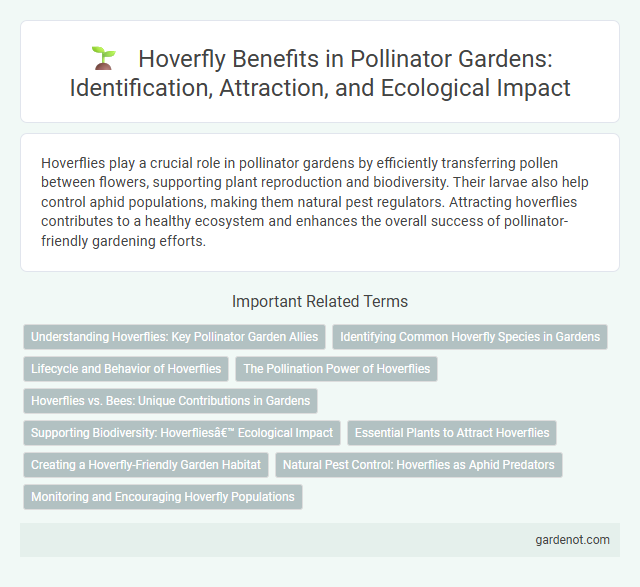Hoverflies play a crucial role in pollinator gardens by efficiently transferring pollen between flowers, supporting plant reproduction and biodiversity. Their larvae also help control aphid populations, making them natural pest regulators. Attracting hoverflies contributes to a healthy ecosystem and enhances the overall success of pollinator-friendly gardening efforts.
Understanding Hoverflies: Key Pollinator Garden Allies
Hoverflies, vital pollinators in garden ecosystems, significantly boost plant reproduction by transferring pollen between flowers. Their larvae consume aphids and other pests, naturally supporting garden health and reducing the need for chemical pesticides. Recognizing hoverflies' dual role enhances pollinator garden management and biodiversity conservation efforts.
Identifying Common Hoverfly Species in Gardens
Common hoverfly species in pollinator gardens include the Syrphus ribesii, known for its distinctive yellow and black banded body resembling a wasp, and the Episyrphus balteatus, identifiable by its vibrant orange coloration and black markings. These hoverflies are often seen hovering near flowers such as marigolds and daisies, playing a crucial role in pollination due to their frequent visits to nectar sources. Recognizing their characteristic flight patterns and body markings helps gardeners encourage these beneficial insects to thrive and enhance garden biodiversity.
Lifecycle and Behavior of Hoverflies
Hoverflies undergo complete metamorphosis with four distinct stages: egg, larva, pupa, and adult, typically completing their lifecycle within a few weeks depending on environmental conditions. Larvae primarily feed on aphids and other soft-bodied insects, playing a crucial role in natural pest control within pollinator gardens. Adult hoverflies exhibit remarkable flight agility, often hovering near flowers while feeding on nectar and pollen, making them effective pollinators in diverse garden ecosystems.
The Pollination Power of Hoverflies
Hoverflies contribute significantly to pollination by transferring pollen as they feed on nectar and pollen from a variety of flowering plants. Their ability to hover enables them to access flowers that other pollinators might miss, increasing plant reproductive success and biodiversity in pollinator gardens. Studies show hoverflies can enhance crop pollination efficiency, making them vital for both natural ecosystems and agricultural production.
Hoverflies vs. Bees: Unique Contributions in Gardens
Hoverflies play a crucial role in pollinator gardens by providing efficient pollination while also controlling pest populations through their larvae, which feed on aphids. Unlike bees, hoverflies do not produce honey but contribute by visiting a wide variety of flowers, enhancing biodiversity and garden health. Their ability to thrive in diverse environments makes them an indispensable complement to bees in maintaining balanced ecosystems.
Supporting Biodiversity: Hoverflies’ Ecological Impact
Hoverflies play a crucial role in supporting biodiversity within pollinator gardens by acting as efficient pollinators for a variety of flowering plants. Their larvae contribute to pest control by feeding on aphids, reducing the need for chemical pesticides and promoting a balanced ecosystem. This dual ecological impact enhances plant reproduction and maintains healthy garden environments, fostering overall biodiversity.
Essential Plants to Attract Hoverflies
Essential plants to attract hoverflies include alyssum, marigolds, and dill, which provide abundant nectar and pollen critical for their nutrition. Umbelliferous flowers such as fennel, coriander, and angelica are highly effective due to their umbrella-shaped blooms that facilitate hoverfly access. Incorporating these diverse flowering plants into a pollinator garden enhances hoverfly populations, promoting natural pest control and improved pollination services.
Creating a Hoverfly-Friendly Garden Habitat
Hoverflies thrive in gardens that provide diverse flowering plants, continuous nectar sources, and pesticide-free environments. Incorporate native flowers with open, shallow blooms such as alyssum, dill, and fennel to attract and support hoverfly populations. Providing shelter with mulch layers and small water sources enhances hoverfly reproductive success and predation on garden pests.
Natural Pest Control: Hoverflies as Aphid Predators
Hoverflies play a crucial role in natural pest control by preying on aphids, a common garden pest that damages plants. Their larvae consume large quantities of aphids, helping to reduce infestations without chemical pesticides. Incorporating hoverflies in pollinator gardens promotes a balanced ecosystem and healthy plant growth.
Monitoring and Encouraging Hoverfly Populations
Monitoring hoverfly populations in pollinator gardens involves regular observation of adult hoverflies and larvae on flowering plants known to attract them, such as umbellifers and wildflowers. Encouraging hoverfly populations requires planting a diverse range of nectar-rich flowers, providing habitat with decaying organic matter for larvae, and minimizing pesticide use to support their lifecycle and pollination activities. Effective management enhances pollination services and natural pest control, benefiting overall garden biodiversity.
Hoverfly Infographic

 gardenot.com
gardenot.com